Many of you have written in asking about DeepSeek’s latest release and its potential effects on our income portfolio and strategies. Let’s discuss the latest in AI because, yes, there are ripples into Dividendland that are not fully appreciated by mainstream investors.
First the DeepSeek disruption in AI, and let’s take vanilla dividend darling Nasdaq 100 Covered Call ETF (NASDAQ:QYLD), which yields 12.2% as our example. Is that big divvie still safe and secure? Income seekers are constantly staring at the fund, writing in to ask me if they have permission to:
- Buy QYLD.
- Collect its monthly dividend.
- Never think about it again.
Not quite. And definitely not now. QYLD is like a breakfast beer. There is a time and a place for it, but it is not something we want to indulge in daily.
QYLD’s strategy is a straightforward approach. It buys the stocks in the Nasdaq 100 and simultaneously sells (“writes”) covered calls on the index itself to generate income. In doing so, QYLD sacrifices potential upside for real cash from the option premiums it collects. Result: Its 12.2% yield.
But note that this options writing does not guarantee a floor on the price of the fund itself. Again, there is a time and a place to buy this thing. Since we last discussed QYLD, it has returned a terrific 26.7% in just 15 months. If you missed it then, well, I wouldn’t chase it now. Especially with the latest DeepSeek news weighing on some outsized positions held by the fund.
AI chatbot DeepSeek sank the Nasdaq last week. Nvidia (NASDAQ:NVDA) shares nosedived from their nosebleed level, shedding 16% in a week. The “problem” for NVDA was that Chinese engineers created a more efficient AI mousetrap, one that does not require endless processing power to run computation after computation after computation. DeepSeek takes shortcuts to find answers, similar to our human brains.
While DeepSeek used NVDA chips, evidence suggests that the company developed its model using less powerful processors. Even if DeepSeek may have obtained NVDA chips illegally via sketchy third parties in Singapore to evade export restrictions, the big takeaway is that its engineers still were not working with the latest chips. So, DeepSeek’s technologists have now shown the world that you can do AI with less money and complex tech. (And they open-sourced their code to cement the accomplishment!)
The big picture is bullish for overall AI adoption. We’ll see greater applications even sooner. But there will be winners and losers and prominent domestic companies here in the US are licking their wounds.
Losers in our dividend portfolios? No. We didn’t touch NVDA, which shareholders dumped to the tune of $600 billion from fear that more efficient AI won’t need its newest chips. But even after the selloff, NVDA shares still trade hands at a swollen 26-times sales. (For perspective, Meta Platforms (NASDAQ:META) fetches 11-times revenues while Alphabet (NASDAQ:GOOGL) (GOOG) and Apple (NASDAQ:AAPL) command 7X and 9X respectively.
Good luck with that. The stock’s paltry 0.03% yield won’t stop sellers.
Which is going to weigh on QYLD—it has a 7.7% position in NVDA! I bet most owners of the fund don’t realize this. They see the 12.2% dividend and think “safe” when really this is anything but.
QYLD also has a 7.8% position in Microsoft (NASDAQ:MSFT), which dropped 6.5% last week in the DeepSeek aftermath. MSFT owns 49% of OpenAI, the “fat cat” of the American AI industry that was caught off-guard by the hungry, savvy Chinese engineers.
And here’s some additional irony. In vintage Chinese fashion there is speculation that DeepSeek engineers “distilled” answers from OpenAI’s ChatGPT to train its ChatBot. (The biggest smoking gun? When asked who it was, DeepSeek replied that it was ChatGPT. Ha!)
This becomes quite embarrassing when we consider that ChatGPT runs on Microsoft’s Azure servers. Microsoft should have caught this. But no. So, DeepSeek “mind melded” with ChatGPT—and now the “parasite” outperforms its “host.”
Bad news for NVDA and MSFT which combine for 15.5% of QYLD. Avoid.
And I haven’t even bitten into Apple, which is drifting off to an antiquated tech island of its own. AAPL has no meaningful AI play and its sales malaise reflects this. Revenues have only climbed 2.5% total over the past three years. If not for inflation, the company would have a shrinking top line, and without buybacks, no meaningful increase in earnings! Apple is QYLD’s largest holding at 9.1%, bringing us 24.6% dead NVDA, MSFT and AAPL weight.
And “America’s ticker” SPDR S&P 500 ETF (SPY) is no safe harbor. (I sarcastically refer to SPY as America’s ticker because it is the most over-owned investment in the land.) SPY carries 19% deadweight in the big three. Bad enough.
There was a time and a place for SPY too and yes, it has had an amazing run. But we are entering a “Trump 2.0” stock market with defined winners and losers. Tariffs protect certain sectors and hurt others. Lower regulation generally helps healthcare… except we now have RFK Jr., who scares healthcare investors. And DeepSeek is disrupting tech.
It no longer makes sense to own everything. Bye-bye, SPY.
We should also avoid QYLD’s analogous Global X S&P 500 Covered Call ETF (NYSE:XYLD). XYLD employs a similar strategy to QYLD but buys S&P 500 stocks while writing covered calls against the index to generate yield. Its 10.6% dividend is enticing, though potentially dicey—XYLD has 20.8% exposure to NVDA, MSFT and AAPL.
A better bet is this life-changing 11% dividend with zero exposure to this troubled tech trio. And its next distribution is just days away.
Disclosure: Brett Owens and Michael Foster are contrarian income investors who look for undervalued stocks/funds across the U.S. markets. Click here to learn how to profit from their strategies in the latest report, "7 Great Dividend Growth Stocks for a Secure Retirement."
